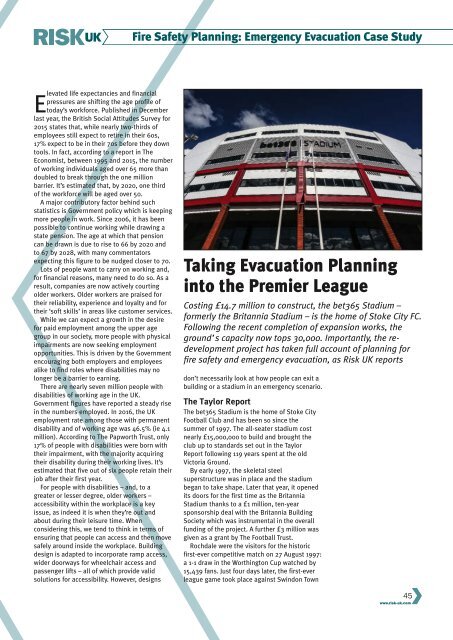RiskUKSeptember2017
Create successful ePaper yourself
Turn your PDF publications into a flip-book with our unique Google optimized e-Paper software.
Fire Safety Planning: Emergency Evacuation Case Study<br />
Elevated life expectancies and financial<br />
pressures are shifting the age profile of<br />
today’s workforce. Published in December<br />
last year, the British Social Attitudes Survey for<br />
2015 states that, while nearly two-thirds of<br />
employees still expect to retire in their 60s,<br />
17% expect to be in their 70s before they down<br />
tools. In fact, according to a report in The<br />
Economist, between 1995 and 2015, the number<br />
of working individuals aged over 65 more than<br />
doubled to break through the one million<br />
barrier. It’s estimated that, by 2020, one third<br />
of the workforce will be aged over 50.<br />
A major contributory factor behind such<br />
statistics is Government policy which is keeping<br />
more people in work. Since 2006, it has been<br />
possible to continue working while drawing a<br />
state pension. The age at which that pension<br />
can be drawn is due to rise to 66 by 2020 and<br />
to 67 by 2028, with many commentators<br />
expecting this figure to be nudged closer to 70.<br />
Lots of people want to carry on working and,<br />
for financial reasons, many need to do so. As a<br />
result, companies are now actively courting<br />
older workers. Older workers are praised for<br />
their reliability, experience and loyalty and for<br />
their ‘soft skills’ in areas like customer services.<br />
While we can expect a growth in the desire<br />
for paid employment among the upper age<br />
group in our society, more people with physical<br />
impairments are now seeking employment<br />
opportunities. This is driven by the Government<br />
encouraging both employers and employees<br />
alike to find roles where disabilities may no<br />
longer be a barrier to earning.<br />
There are nearly seven million people with<br />
disabilities of working age in the UK.<br />
Government figures have reported a steady rise<br />
in the numbers employed. In 2016, the UK<br />
employment rate among those with permanent<br />
disability and of working age was 46.5% (ie 4.1<br />
million). According to The Papworth Trust, only<br />
17% of people with disabilities were born with<br />
their impairment, with the majority acquiring<br />
their disability during their working lives. It’s<br />
estimated that five out of six people retain their<br />
job after their first year.<br />
For people with disabilities – and, to a<br />
greater or lesser degree, older workers –<br />
accessibility within the workplace is a key<br />
issue, as indeed it is when they’re out and<br />
about during their leisure time. When<br />
considering this, we tend to think in terms of<br />
ensuring that people can access and then move<br />
safely around inside the workplace. Building<br />
design is adapted to incorporate ramp access,<br />
wider doorways for wheelchair access and<br />
passenger lifts – all of which provide valid<br />
solutions for accessibility. However, designs<br />
Taking Evacuation Planning<br />
into the Premier League<br />
Costing £14.7 million to construct, the bet365 Stadium –<br />
formerly the Britannia Stadium – is the home of Stoke City FC.<br />
Following the recent completion of expansion works, the<br />
ground’s capacity now tops 30,000. Importantly, the redevelopment<br />
project has taken full account of planning for<br />
fire safety and emergency evacuation, as Risk UK reports<br />
don’t necessarily look at how people can exit a<br />
building or a stadium in an emergency scenario.<br />
The Taylor Report<br />
The bet365 Stadium is the home of Stoke City<br />
Football Club and has been so since the<br />
summer of 1997. The all-seater stadium cost<br />
nearly £15,000,000 to build and brought the<br />
club up to standards set out in the Taylor<br />
Report following 119 years spent at the old<br />
Victoria Ground.<br />
By early 1997, the skeletal steel<br />
superstructure was in place and the stadium<br />
began to take shape. Later that year, it opened<br />
its doors for the first time as the Britannia<br />
Stadium thanks to a £1 million, ten-year<br />
sponsorship deal with the Britannia Building<br />
Society which was instrumental in the overall<br />
funding of the project. A further £3 million was<br />
given as a grant by The Football Trust.<br />
Rochdale were the visitors for the historic<br />
first-ever competitive match on 27 August 1997:<br />
a 1-1 draw in the Worthington Cup watched by<br />
15,439 fans. Just four days later, the first-ever<br />
league game took place against Swindon Town<br />
45<br />
www.risk-uk.com

















